21 December. New swarms form and invade Kenya
The Desert Locust situation has become more serious in Kenya and Ethiopia where new swarms have formed and are starting to move.
In Ethiopia, large infestations of hopper bands (wingless nymphs) are present in the southeast and east of the country, extending from the Ogaden in the north to the Kenyan border in the south. Most of the infestations are near Warder and Gode. New infestations have been detected further west towards the Rift Valley, in the south between Negele and Teltele, and near the Dawa River along the Kenyan border. Some of the hopper infestations have fledged and the immature adults are forming swarms. The hoppers have caused damage to crops and pasture, particularly in the Gode area.
In Kenya, numerous small hopper bands are present in the northeastern districts of Mandera and Moyale. On 19 December, a medium density immature swarm crossed the Dawa River from southern Ethiopia and settled west of Mandera. It took more than 1.5 hours to fly overhead and its size was estimated to be about 5 km long by 3 km wide. A second swarm was seen the same day.
National plant protection teams in both countries are conducting ground control operations against the current locust infestations. The Desert Locust Control Organization for Eastern Africa (DLCO-EA) is reinforcing these operations with aircraft and experts for survey and control. Many of the hopper infestations in northeast Kenya have been treated but control in Ethiopia is limited because numerous areas are not safe or accessible.
The current situation is less well known in adjacent areas of central and southern Somalia where similar locust infestations may be present.
During the remainder of December, an increasing number of new immature swarms will form in eastern and southern Ethiopia (and probably Somalia). Some of these swarms may be large and dense. The swarms are expected to be highly mobile and voracious. Immature swarms pose the greatest threat to agriculture. The swarms are likely to move south and southwest into southwest Ethiopia and into northern Kenya between Mandera and Turkana. From early January onwards, new immature swarms will also form in northeast Kenya from any current hopper band infestations that are not controlled.
Although most of the swarms are expected to move in southern Ethiopia and northern Kenya, there is a slight risk that a few swarms could reach northeast Uganda and a very low risk of reaching northern Tanzania.
All measures should be taken to control the current infestations, reduce the threat to crops and pasture, and to prevent the further increase and spread of locust swarms.
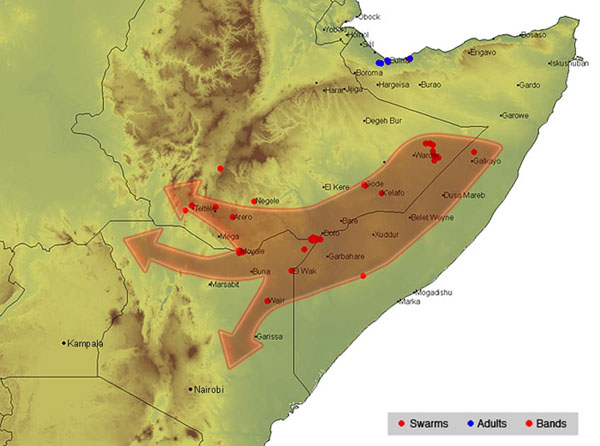
New swarms will form and move south and southwest in Ethiopia and Kenya during the next few weeks.
11 December. Significant infestations in E. Africa, new reports from Arabia
The Desert Locust situation remains serious in northeast Kenya and southeast Ethiopia. There have been new reports of infestations further west in both countries.
In Kenya, at least one mature swarm crossed the Ethiopian border into Moyale District (west of Mandera) where it was seen near Goda on 30 November. In Mandera District, hatching started at the end of November and continued during the first week of December. Currently, first and second instar hopper bands have formed in Neboi, Fikow, Burabor and Bella areas at densities of more than 2,000 hoppers per square metre. DLCO-EA and Kenyan Plant Protection teams started aerial and ground control operations on the 6th. So far, no locusts have been reported further south in Wajir District.
Although the situation appears to be under control at the moment in Mandera District, there have been a number of unconfirmed reports of hopper bands across the border in southern Somalia (where survey and control operations are not possible) and in southeast Ethiopia. Any hopper infestations that are not found and controlled will start to form new swarms during the first week of January.
In southeast Ethiopia, locust adults have been seen flying in the Borena zone of Oromiya region which is west of the Ogaden and north of Kenya. Large numbers of adult locusts were reported in the districts of Moyale, Dire, Arero and Yabelo.
In Sudan, locusts are still present in the interior north of Khartoum but are declining in number. Two immature swarms were seen recently on the western side of the Red Sea Hills and one swarm was seen in the Northern Region. On the coast, new hatching is underway in the Tokar Delta. Control operations are in progress in all areas.
In Saudi Arabia, new reports indicate that small groups of immature gregarious adults have been seen on the Red Sea coast between Jeddah and Yenbo and near Medinah. These may be local populations mixed with some adults that crossed the Red Sea from Sudan.
In southern Oman, control operations are in progress against small groups of adults that are laying eggs northeast of Salalah.
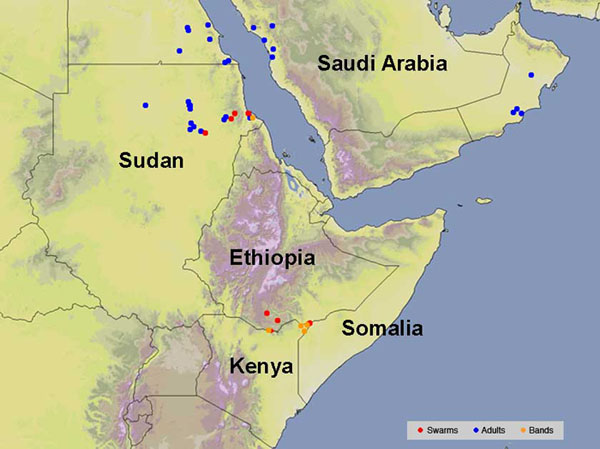
Locusts are present in NE Kenya, SE Ethiopia, NE Sudan, Saudi Arabia and S Oman.
3 December. Desert Locust swarms in northeast Kenya, hopper bands in eastern Ethiopia
For the first time since 1961, several Desert Locust swarms invaded northeastern Kenya and are thought to have laid eggs between Mandera and Elwak. The eggs are expected to hatch in about a week and small hopper bands are likely to form. Some crop damage was reported along the Dawa River on the Ethiopian-Kenyan border. The Government of Kenya and the Desert Locust Control Organization for Eastern Africa (DLCO-EA) are taking steps to organize a control campaign against the hoppers.
In eastern Ethiopia, hopper bands are forming in the Ogaden region. A similar situation may be in progress in adjacent areas of central and southern Somalia where survey and control operations are not possible. Any bands that are not controlled will start to form new swarms in about mid-December. These swarms are expected to move south into Kenya towards the border of Tanzania. Hopper bands that are not controlled in Kenya could form new swarms in mid-January and move southwards.
Therefore, all efforts should be made to monitor this developing and potentially dangerous situation closely and carefully, and to undertake control as necessary.
In Sudan, several swarms have formed from summer breeding in the interior and are moving east towards the Red Sea coast where breeding is already in progress. On the coast, small hopper bands have formed in the main agricultural area, Tokar Delta. Survey and control operations are in progress.
Groups of locust adults have been reported in several oases in the Western Desert in Egypt, and a few locust adults were seen in Cairo. These locusts have probably originated from summer breeding in Sudan as well as from local breeding in Upper Egypt near Lake Nasser and Jebel Uweinat. Surveys are underway and limited control operations have been carried out.
Apart from Sudan, only small-scale breeding has occurred so far in the winter breeding areas along both sides of the Red Sea and Gulf of Aden, mainly in southeastern Egypt, northeastern Eritrea, in Yemen, in northwest Somalia and probably in Saudi Arabia. Breeding will continue in these areas during the next few months, causing locust numbers to increase gradually.
The situation remains calm in West and Northwest Africa, and in southwest Asia.
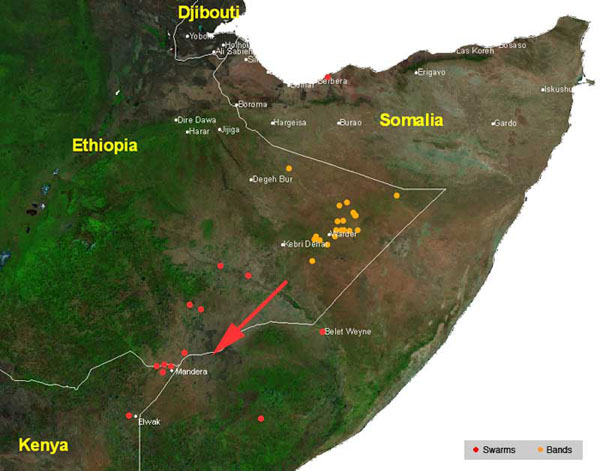
Swarms have laid eggs that are hatching and forming hopper bands in eastern Ethiopia. Some swarms continued south and laid eggs in northeast Kenya.
21 November. Desert Locust swarms invade northeast Kenya and lay eggs
For the first time in more than 45 years, several small Desert Locust swarms have invaded northeast Kenya in the past few days. The swarms are mature, low density and in the process of laying eggs in the districts of Mandera and Kalala near the borders of Ethiopia and Somalia. Crop damage has been reported near the Dawa River on the Ethiopian border.
The swarms originated from summer breeding in the interior of Yemen where they moved across the Gulf of Aden in September to northern Somalia. During October, the swarms matured and drifted across northern Somalia, moving into eastern Ethiopia where they laid eggs in the Ogaden region by the end of the month. A few swarms have also been reported in adjacent areas of Somalia near Belet Weyne and, more recently, in the Juba region near Kenya. A few more small swarms could still appear in northeast Kenya in the coming days but it is extremely unlikely that a large invasion will occur due to the low number of swarms currently present in the region. Ground teams are being mobilized to clarify the situation, assess the extent of the infestations and undertake any control operations as necessary. An aircraft has been placed on standby.
During the first week of December, hatching is expected to occur in northeast Kenya and small hopper bands will form. It will take about four weeks before the wingless hoppers develop into adults. Thereafter, small swarms are expected to start to form in early January and continue during the remainder of the month. There is a moderate to high risk that these newly formed swarms will move further south in Kenya and threaten agriculture.
In eastern Ethiopia, hatching started in early November in the Ogaden region between Kebri Dehar and Warder, and hoppers are forming small dense bands. By the end of December, most of the hoppers are expected to fledge and there is a moderate risk that small swarms will form which could move south towards Kenya in January.
In northeastern Sudan, a Desert Locust outbreak is still in progress where small hopper bands formed in the Baiyuda Desert north of Khartoum, on the western side of the Red Sea Hills and northwest of Kassala. Most of the hoppers have fledged and the newly immature adults are forming small groups. Control operations are underway. As vegetation continues to dry out in the interior, the adults will form more small groups and perhaps a few small swarms. These populations will move east to the Red Sea coastal plains and lay eggs mainly between Port Sudan and the Eritrean border. Some populations could also move to the northern Red Sea Hills and Wadi Diib. Eggs will hatch and hoppers are likely to form small bands during December.
Local breeding has already occurred on the Red Sea coast in the Tokar Delta in Sudan where hoppers have formed small groups and bands. Breeding also occurred on the coast of Yemen and will continue if more rains fall. Smaller-scale breeding is likely to take place along parts of the Red Sea coast in Saudi Arabia, northern Eritrea and southeastern Egypt.
Consequently, this winter will be very important as there is a strong possibility that locust numbers will increase significantly on the Red Sea coast in Sudan and, to a lesser extent, in Yemen during November and December. A similar situation is expected in the Horn of Africa. All efforts should be made to monitor this developing and potentially dangerous situation closely and carefully, and to undertake control as necessary.
Elsewhere, the situation remains calm and no significant developments are expected.
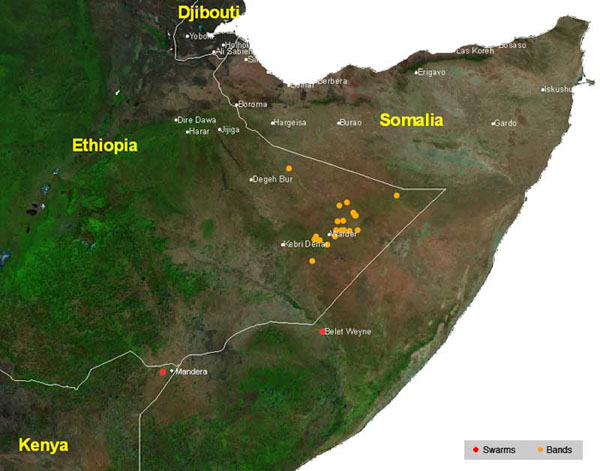
Hatching and band formation (orange) are in progress in eastern Ethiopia while swarms (red) are laying eggs in northeast Kenya.
5 November. Desert Locust outbreak in Sudan
A Desert Locust outbreak has developed in northern Sudan where small hopper bands have formed in the Baiyuda Desert north of Khartoum, on the western side of the Red Sea Hills and northwest of Kassala. Many of the hoppers have fledged and the newly immature adults are forming small groups. Ground control operations are underway and more than 5,000 ha have been treated in the past few days. As vegetation continues to dry out in the interior, the adults will form more small groups and perhaps a few small swarms. These populations are expected to move east to the Red Sea coastal plains and lay eggs mainly between Port Sudan and the Eritrean border. Some populations could also move to the northern Red Sea Hills and Wadi Diib. Eggs will hatch and hoppers are likely to form small bands during November.
Local breeding has already occurred on the Red Sea coast in the Tokar Delta in Sudan where hoppers have formed small groups and bands. Breeding also occurred on the coast of Yemen and will continue if more rains fall. Smaller-scale breeding is likely to take place along parts of the Red Sea coast in Saudi Arabia, northern Eritrea and southeastern Egypt.
Consequently, this winter will be very important as there is a strong possibility that locust numbers will increase significantly on the Red Sea coast in Sudan and, to a lesser extent, in Yemen during November and December. All efforts should be made to monitor this developing and potentially dangerous situation closely and carefully, and to undertake control as necessary.
In the Horn of Africa, a few swarms moved from northern Somalia into the Ogaden in eastern Ethiopia last month. They will probably lay eggs in November. There is a very low risk that some locusts could reach northeastern Kenya.
Elsewhere, the situation remains calm and no significant developments are expected.
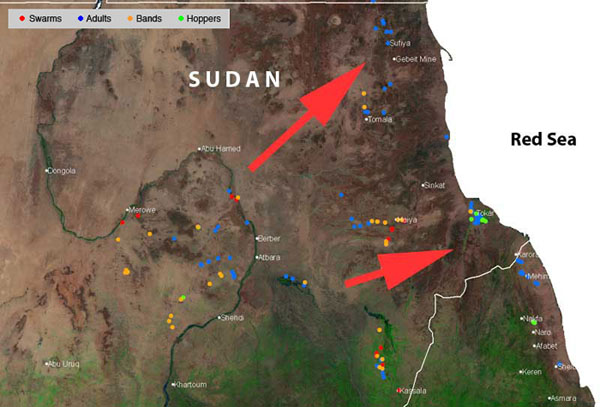
Important Desert Locust infestations are present in the interior of northern Sudan that will move towards the Red Sea coast.
30 October. Desert Locust swarms and breeding in Ethiopia's Ogaden
During the past week, there have been several reports of Desert Locust swarms in the Somali Region of eastern Ethiopia. Locusts were first seen in the eastern zone of Warder coming from northern Somalia during the third week of October. They quickly spread west in the Ogaden to the zones of Degehabur (Gashamo district), Korahe (Kebridahar, Dobowien, Sheygosh districts) and, most recently, Fik. The total number of swarms is thought to be small but as they are moving, there have probably been multiple sightings of the same swarm. The adults are already mature so they will lay eggs in areas where vegetation is green and soil is moist rather than moving large distances. Nevertheless, there is a moderate risk of locusts reaching the western portion of the Somali Region and moving further south to the Shebele River.
Egg-laying already occurred in Warder in early October. On the 27th, a survey and control team from the Ministry of Agriculture and Rural Development confirmed that small second instar hopper bands had formed at two places in Warder zone but control operations were not possible. The hoppers will fledge and could form a small immature swarm in about one month.
Currently, the risk of swarms moving further south and reaching Kenya is assessed to be very low. Intensive surveys should be maintained in the Ogaden during the coming weeks as a means of early warning for Kenya.
Recent reports indicate that the current Desert Locust situation is calm in northern Somalia.
In Sudan, ground and aerial control operations have commenced against small hopper bands that formed in the River Nile, Northern, Kassala and Red Sea states. Hoppers are fledging and are expected to form groups of adults and perhaps a few small swarms that will move to the Red Sea coast in the coming weeks.
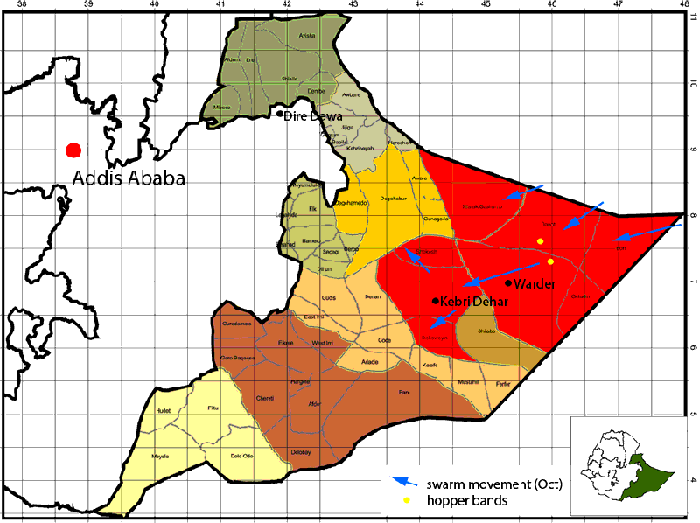
Swarms have been seen moving in several zones and districts (in red) of eastern Ethiopia during the past week.
17 October. Hopper bands in Sudan and Yemen
In northern Sudan, several small hopper bands formed earlier this month from local breeding that occurred north of Khartoum, along the Atbara River and on the western side of the Red Sea Hills. Three small swarms were seen copulating close to the Nile at Merowe and to the northwest of Kassala. Small-scale breeding is in progress on the Red Sea coast in the Tokar Delta.
In Yemen, about a half dozen hopper bands formed on the northern Red Sea coast near Suq Abs. Small-scale breeding is in progress elsewhere along the coastal plains between Bayt Al Faqih and the border of Saudi Arabia. Scattered adults are present on the southern coast near Aden.
Limited ground control operations were carried out in Sudan and Yemen. The situation requires careful and regular monitoring in both countries.
In northern Somalia, a few highly mobile swarms moved from the northwest to Puntland in the northeast and then south towards Galkacyo. They were last seen crossing into the northeastern portion of the Ogaden in Ethiopia.
In Mauritania, small-scale breeding occurred west of NBeika. Scattered adults are present in Tagant, Brakna, Trarza and southwest Adrar regions.
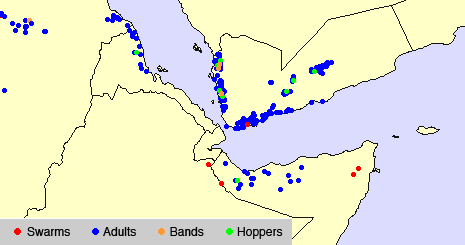
Locust infestations will concentrate along both sides of the Red Sea during the winter and increase in number.
3 October. Hopper bands form on the Red Sea coast in Yemen
Local breeding is in progress on the Red Sea coastal plains in Yemen where conditions have been unusually favourable for several months. In the last few days, hoppers have formed several small bands on the northern coast near Suq Abs. On the central coast, hoppers were grouping south of Hodeidah. Groups of adults continue to lay eggs in many areas but so far no swarms have reached the coast from the interior of Yemen.
Local breeding is also in progress along the coastal plains in Eritrea and Sudan where groups of adults laid eggs last month. Hatching is expected in the coming days in Tokar Delta, Sudan and in Eritrea near Mehimet in the north and near Shieb on the central coast. During October, breeding is expected to extend to other areas along the coast in both countries and in southwest Saudi Arabia near Jizan.
Breeding has occurred along both sides of the Red Sea several months earlier than normal this year because of good rainfall since August. Consequently, there is a high risk that locusts will increase dramatically in the coming months.
Locust infestations continue to decline in outbreak areas in the interior of Yemen as vegetation dries out. A few more swarms could still form from residual populations in October and move into the central highlands and to the southern coast near Aden. There is a moderate risk that some of these swarms could cross the Gulf of Aden to northern Somalia. Recent reports of swarms in northeast Somalia are being verified.
Seasonal rains have ended in summer breeding areas in West Africa and along the Indo-Pakistan border where further breeding is unlikely this year.

Locust infestations will concentrate along both sides of the Red Sea during the winter and increase in number.
24 September. Swarms reported in northern Somalia and eastern Ethiopia
A Desert Locust swarm was seen flying yesterday afternoon over Hargeisa in northern Somalia. It was reportedly flying high suggesting that it may have come from southern Yemen where breeding occurred since April in the interior. Survey and control operations are being organized near Hargeisa.
In northeastern Somalia, there have been several reports of locusts during the past few days. Locusts were first reported near Iskushuban (1017N/5014E) on 16 September. Yesterday, locust swarms were reported over Gardo (0930N/4905E). It is unclear if these are local infestations or from Yemen.
Swarms have also been reported since 21 September in eastern Ethiopia along the Djibouti and northern Somalia borders near Aysha and Teferi Ber. Surveys teams are being deployed to the infested areas.
During the remainder of September, there is a risk that a few more swarms may cross the Gulf of Aden from southern Yemen and reach the plateau in eastern Ethiopia and northern Somalia. Swarms that appear near Hargeisa are likely to drift east towards Burao, Erigavo, Gardo and Iskushuban (see map).
All reports of locusts, whether confirmed or not, should be sent immediately to the FAO Desert Locust Information Service ([email protected]) and include digital photos whenever possible.
The situation remains calm in other countries.
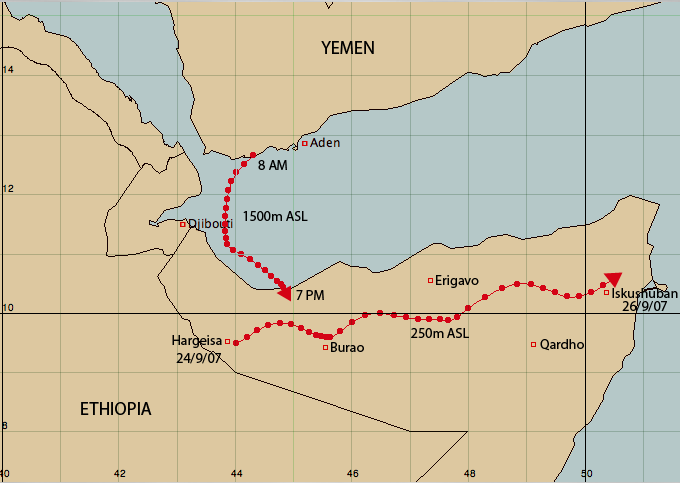
In order to cross the Gulf of Aden from Yemen to northern Somalia, Desert Locusts must fly on high-level winds. The journey takes one day and is likely to carry locusts to the Somali plateau. Once the locusts are on the plateau, they are likely to move east along a convergence zone to Burao, Gardo and Iskushuban as indicated by the results of a trajectory model.
18 September. Swarms move to the south coast of Yemen
During the past week, most of the Desert Locust activity remained concentrated in Yemen. Locusts are declining in the interior where breeding occurred since April but vegetation is now drying out. Most of the locusts are moving towards the coast while some may be in the central highlands. So far, several small swarms have arrived on the southwest coast near Aden and control operations are in progress. Some swarms have tried to move across the Gulf of Aden to northern Somalia. Earlier this week, fishermen reported dead locusts in the sea near Aden and locals reported low numbers of gregarious adults in northern Somalia near Hargeisa and Erigavo. Locusts are also expected to arrive on the Red Sea coast in Yemen and perhaps on the coast in Sudan and Eritrea. This year, breeding by local populations has started early than normal on the coast in Sudan and Eritrea, and survey teams are monitoring the situation closely.
Heavy rains have caused flooding in West Africa and Sudan. In West Africa, most of the rains and floods were well south of the Desert Locust breeding areas while in Sudan, some breeding areas were affected. Surveys are in progress in Mauritania where, so far, only small-scale breeding has been detected which is normal for this time of year. Surveys are not possible in northern Mali, northwest Niger and western Sudan due to insecurity. Despite what has been mentioned recently in the media, it is very unlikely that a locust invasion will occur in West Africa because of the floods this year.
Elsewhere, small scale breeding is in progress in northeast Oman that was affected by cyclone Gonu in June. Summer breeding is coming to an end along both sides of the Indo-Pakistan border where only low numbers of locusts are present.
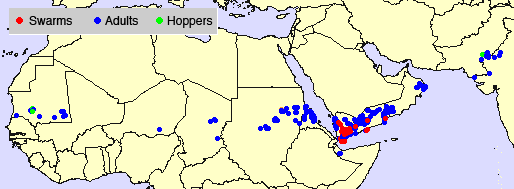
Current locust infestations.
3 September. Swarms move into Yemen highlands and southern Oman
The Desert Locust situation has worsened in Yemen as immature swarms formed in the interior regions of Hadhramaut and Al-Mahara and moved last week into the central highlands. Swarms are still forming in the interior where most of them are expected to move west to Shabwah, Marib and Al-Jawf regions, mature and lay eggs in the coming weeks. Hence, another generation of breeding could occur in the interior which will cause locust numbers to increase further.
Any swarms that reach the central highlands in Yemen are unlikely to breed but they may remain there for a few days or weeks and threaten crops. Eventually, the swarms should reach the coastal plains of the Red Sea in Yemen and Saudi Arabia where rains have been falling for the past three months. Consequently, conditions on the coast are already favourable to allow the locust adults to mature and lay eggs from the end of September onwards. So far, only local solitarious infestations are present on the Yemeni coast, and there were unconfirmed reports of locusts near Jizan, Saudi Arabia a few days ago.
Some swarms that reach the Red Sea coast could cross the sea to the coastal plains of Eritrea and Sudan. Local populations of solitarious adults are already present on the northern coast of Eritrea between Mehimet and Karora and in the Tokar Delta in Sudan. Vegetation is becoming green on the coast from good rains and recent runoff from the highlands.
During periods of strong northerly winds, swarms from the Yemen interior could also reach the coastal plains near Aden and perhaps cross the Gulf to northern Somalia. Other swarms may move from eastern Yemen to southern Oman where they could continue further north to the Sharqiya region in Oman. If so, there is a slight risk during the next two weeks that a few swarms could continue to the Indo-Pakistan border. Thereafter, this risk should pass.
Aerial and ground control operations are in progress in the interior of Yemen. Not all infested areas could be surveyed or treated because of insecurity and the presence of beehives.
Heavy rains in the past month have caused flooding in the interior of Sudan and western Eritrea. This will allow breeding conditions to become favourable and consequently, locusts will increase and could gregarize in the coming months in the traditional summer breeding areas in both countries.
The present situation could lead to a significant increase in locusts in the Region during the coming months, first in the summer breeding areas, then in the winter breeding areas on the Red Sea and Gulf of Aden coasts. Countries should take immediate steps to monitor these areas and carry out control operations as required. Some of these activities may need additional assistance from the international community.
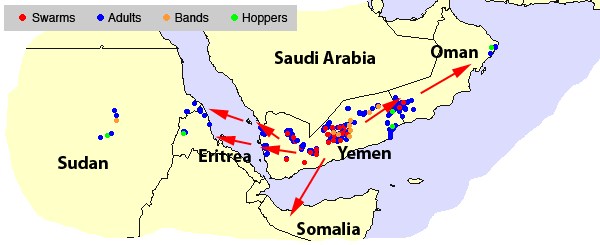
Current locust infestations in Yemen and potential migrations.
2 August. Extremely serious situation continues in Yemen
For a third consecutive month, the Desert Locust situation remains threatening and extremely serious in the summer breeding areas in Yemen. Egg-laying, hatching and band formation continued last month within a portion of the interior. The most important infestations are in remote wadis in the plateau north of Wadi Hadhramaut, extending from Al Abr in the west to the Oman border in the east. Other infestations are present in Wadi Hadhramaut itself as well as in the traditional breeding areas in Shabwah region near Bayhan and Ataq.
During the past week, many of the hopper infestations have fledged and the young immature adults are forming groups and small swarms. Some of the swarms are moving into crops. In the past few days, new infestations have been found in areas that had not been surveyed previously. For example, groups of hoppers and adults are present in remote wadis of the interior of Al-Mahara region near the Oman border. Other infestations were discovered in wadis in the plateau south of Wadi Hadhramaut.
Ground teams using vehicle-mounted equipment have treated nearly 19,000 ha since 4 July in some areas. However, control operations are hampered by the presence of beehives and because many infestations are in extremely remote areas. Nearly a dozen teams are working in the field. A fixed-wing aircraft is undertaking aerial control operations that started yesterday. A helicopter will assist ground teams in surveying the extent of the infestations and identifying control targets.
More swarms will form during August. As vegetation dries out, swarms are likely to move within the vast interior between Marib and the Oman border where they will mature in areas that remain green. If more rainfall occurs, egg laying could start by the end of August with another generation of hatching and band formation in September. Most of the swarms that form during August are expected to stay in the interior but there is a slight risk that some swarms could move to the Sana'a highlands and to the Red Sea coastal plains where good rains have fallen, or to southern Oman and continue to the Indo-Pakistan border.
Elsewhere, the situation remains calm. Small-scale breeding will occur during August in the northern Sahel in Mauritania, Mali, Niger, Chad and Sudan, causing locust numbers to increase slightly. Similarly, small-scale breeding is in progress in desert areas along both sides of the Indo-Pakistan border.

Most of the swarms are likely to stay in Yemen.
6 July. Threat of possible swarm migration to India and Pakistan declines
After several Desert Locust swarms moved east across northern Somalia in late June, there was a risk that they would continue across the Indian Ocean and reach Pakistan and India.
So far, only a few small groups of immature adults have been reported in coastal areas of Kutch in Gujarat, India on 3-4 July. Although these locusts may have arrived from northeastern Somalia, they are not in sufficient numbers to constitute a swarm or pose a threat to the region. Furthermore, there have been no reports of swarms from other countries in the region and only scattered adults remain in northern Somalia.
Currently, only scattered solitarious adults are present in the traditional summer breeding areas in parts of Rajasthan and Gujarat as well as in southeast Pakistan. It is normal for low numbers of locusts to be present in these areas during the summer when one generation of breeding occurs in desert areas which receive the monsoon rains.
If there are no sightings of swarms in Gujarat or adjacent areas of Pakistan in the next 2-3 days, it is likely that the threat of a swarm invasion has passed.
In Yemen, the situation continues to remain extremely serious and potentially dangerous. Widespread egg-laying and hatching is in progress within a large portion of the interior between Marib and Thamud. The young hoppers are forming small bands. Most of the infestations are concentrated in the numerous wadis that bissect and drain the plateau between Al Abr and Thamud. Infestations are also present on the edge of the Empty Quarter and have spread into Ramlat Sabatyn and Shabwah areas. Limited ground control operations have been mounted against some infestations that are in cropping areas; however, the majority of operations will commence later this month in an aerial campaign involving two helicopters being organized by FAO. The operations are financed by the UN Emergency Fund, Japanese assistance and resources from the Government of Yemen.
The Desert Locust situation remains calm in the other regions.
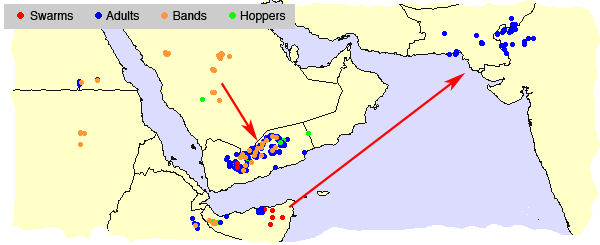
Desert Locust swarms migrate with the wind. Prevailing winds could carry swarms from NE Somalia to India and Pakistan.
4 July. LOCUST WARNING! Possible swarm migration to India and Pakistan
Several Desert Locust swarms moved east across northern Somalia from eastern Ethiopia to Hargeisa and Sanaag, reaching Bosasso (1118N/4904E) last week. Since then, there have been no new reports of locusts in northeast Somalia and only scattered adults are present on the escarpment and coast near Berbera in the northwest.
The swarms are likely to continue to migrate on southwesterly winds that are associated with the southern Asia monsoon. These winds could carry the locusts from northeast Somalia across the Indian Ocean to the coast of Pakistan and northwest India (Bhuj, Gujarat) this week. This migration could take about 3-4 days and the locusts may temporarily land on the coast of central Oman. So far there have been no sightings in Oman or from ships in the Indian Ocean.
Last week, cyclone Yemyin brought heavy rains and flooding to coastal and inland areas extending from Baluchistan in western Pakistan to Sindh in southeast Pakistan, and Gujarat and Rajasthan in India. Consequently, a few swarms could appear in the coming few days in any of these areas. If so, they are likely to mature quickly and lay eggs that will hatch later this month.
Both countries have been warned and they are taking the necessary precautions such as mobilizing field teams and control resources to the threatened areas. It is important that intensive monitoring of the summer breeding areas is carried out and that effective and safe control operations can be mounted quickly as required.
The situation remains extremely serious and potentially dangerous in Yemen. Widespread egg-laying and hatching is in progress within a large portion of the interior between Marib and Thamud. The young hoppers are forming small bands. Most of the infestations are concentrated in the numerous wadis that bissect and drain the plateau between Al Abr and Thamud. Infestations are also present on the edge of the Empty Quarter and have spread into Ramlat Sabatyn and Shabwah areas. Limited ground control operations have been mounted against some infestations that are in cropping areas; however, the majority of operations will commence later this month in an aerial campaign involving two helicopters being organized by FAO. The operations are financed by the UN Emergency Fund, Japanese assistance and resources from the Government of Yemen.
Reports of locusts in the Juba River basin in southern Somalia during the past few days were of grasshopper infestations.
The Desert Locust situation remains calm in the other regions.

Desert Locust swarms migrate with the wind. Prevailing winds could carry swarms from NE Somalia to India and Pakistan.
27 June. LOCUST WARNING! Possible swarm migration to India and Pakistan
Locust swarms have been seen in northeastern Somalia near Bosasso (1118N/4904E) on 23-25 June. The prevailing winds are from the southwest - the same winds that are associated with the southern Asia monsoon. If these are Desert Locust swarms, estimates from a trajectory model suggest that the swarms could move with the monsoon winds in a northeasterly direction from northeast Somalia across the Indian Ocean to Bhuj, India and southern Sindh, Pakistan. This migration would take about 3-4 days.
Consequently, there is a high probability that several swarms could arrive in the summer breeding areas of Tharparkar, Pakistan and Rajasthan, India at any time during the next 7-10 days. This area recently received heavy rains associated with cyclone Yemyin. There is a low chance that the swarms will land temporarily in coastal areas of Oman and perhaps southern Yemen where they would overnight before resuming their flight in the morning.
India and Pakistan should be on high alert and take the necessary precautions to insure that intensive monitoring of the summer breeding areas is carried out and that effective and safe control operations can be mounted quickly if required.
In Yemen, survey teams are finding more hopper and adult infestations in the remote interior between Al Abr and Thamud. Egg-laying, hatching and band formation are in progress. FAO, in collaboration with WFP, is mounting aerial operations that will commence in mid-July. The operations are being financed by the UN Emergency Fund, Japanese assistance and resources from the Government of Yemen.
Swarms were also reported in northwest Somalia near Hargeisa in the past week. The current situation is being clarified.
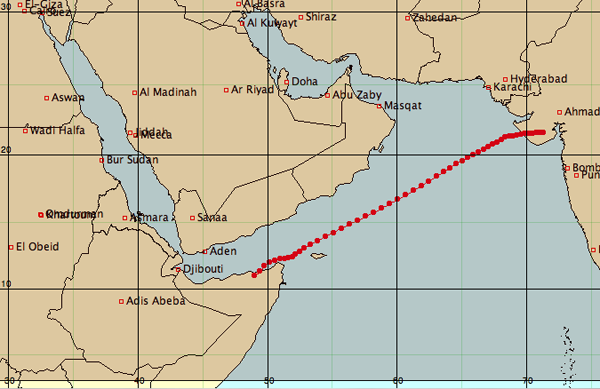
Desert Locust swarms migrate with the wind. Prevailing winds could carry swarms from NE Somalia to India and Pakistan.
20 June. Aerial operations being organized in Yemen
The Desert Locust situation is extremely serious in the interior of Yemen where substantial breeding has taken place because of unusually heavy rains that fell over a large and remote area on the southern edge of the Empty Quarter. A second generation of egg-laying is in progress and hatching has already started in a few places. More hatching will occur and hopper bands will form in the coming weeks. Recent surveys have found additional infestations in some remote wadis in the Hadhramaut region. Breeding is also in progress in Shabwah governorate.
FAO is organizing aerial operations supported by the UN Emergency Fund and assistance from the Government of Japan and the World Food Programme. The operations are planned to commence in mid-July and will be carried out against hopper bands and adult swarms in order to minimize the threat to crops, pasture and neighbouring countries.
In Southwest Asia, control operations treated hoppers and adults that were forming groups on the southeastern coast of Iran in areas affected by cyclone Gonu earlier this month. Smaller infestations were treated near Uthal, Pakistan. Egg-laying is in progress in the summer breeding areas in Rajasthan, India near the Pakistani border.
Small-scale breeding is expected to occur in the Sahel of West Africa (Mauritania, Mali, Niger and Chad) once the seasonal rains commence.
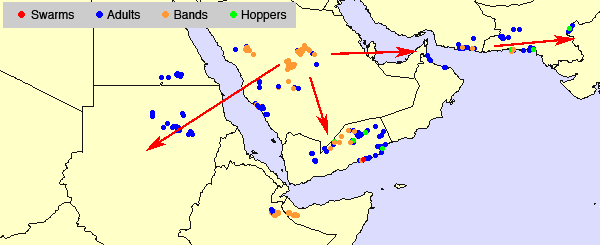
Any swarms that form which are not controlled in the interior of Saudi Arabia could move to Sudan and Yemen and, perhaps, to Oman and Iran.
6 June. Situation level raised to THREAT; Aerial operations required in Yemen
The Desert Locust situation has become extremely serious in the interior of Yemen where substantial breeding has taken place because of unusually heavy rains. Hopper bands have formed over a large and remote area on the southern edge of the Empty Quarter. Swarms are expected to form in June and remain in the area and lay eggs by the end of the month. The eggs will hatch in July and another generation of hopper bands will form.
Consequently, aerial operations requiring external assistance will need to be mounted in July to avoid the formation of second generation swarms and to minimize the threat to crops and pasture.
Aerial and ground control operations continue against hopper bands in the interior of Saudi Arabia. There is a risk that swarms could form and, if not controlled, will move to Yemen and Sudan. There is also a chance that a few swarms could reach areas in Oman and southern Iran affected by tropical cyclone Gonu.
Control operations are also in progress against smaller infestations of hopper bands on the southeastern coast of Iran, the coast of western Pakistan and on the border of Ethiopia and northern Somalia.
Small-scale breeding is underway in the Nile Valley in Sudan north of Khartoum.
Summer breeding will commence in the Sahel of West Africa (Mauritania, Mali, Niger and Chad) and Sudan with the onset of the seasonal rains. Initially, populations will remain low.
This year higher than normal populations will be present at the beginning of the summer along the Indo-Pakistan border where breeding will start with the arrival of the monsoon rains.

Any swarms that form which are not controlled in the interior of Saudi Arabia could move to Sudan and Yemen and, perhaps, to Oman and Iran.
10 May. Control operations underway in Saudi Arabia, Ethiopia, Sudan and India
The Desert Locust situation remains serious on the Arabian Peninsula and in the Horn of Africa but has improved along the western side of the Red Sea.
In Saudi Arabia, aerial and ground control operations continue on the Red Sea coast against late instar hopper bands and residual groups of mature adults, and in the interior against mature swarms that are laying eggs. Teams treated nearly 13,000 ha on 1-10 May. Hatching is expected to occur this week in the interior and small hopper bands could form that, if uncontrolled, will become adults and perhaps small swarms by mid-June.
In Yemen, hatching and hopper band formation is underway in the interior near Al-Abr and Thamud. Small adult groups and perhaps a few swarms could form in breeding areas on the southern coast near Sayut and move into the Hadhramaut interior. Control operations have not been implemented yet because of beekeepers in the area.
In Ethiopia, control operations are in progress against hatchlings and young hopper bands near Dire Dawa.
In Sudan, a few groups of immature and mature adults were treated in crops along the Nile between Atbara and Dongola. Small-scale breeding is expected in the coming weeks. Survey and control operations are declining on the Red Sea coast near the Eritrean border.
In India, ground teams treated gregarizing hoppers, fledglings and a mature swarm west of Jaisalmer near the Pakistan border.
All efforts should be made to monitor the developing and potentially dangerous situation closely and carefully.
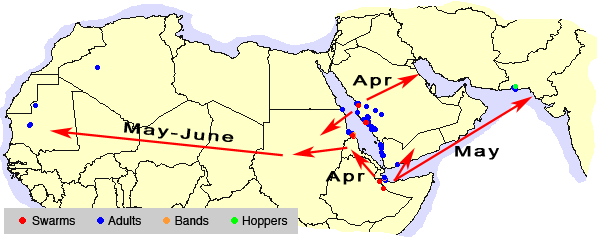
Red arrows indicate potential locust movements under the WORSE case scenario.
3 May. Spring breeding underway in Saudi Arabia, Yemen, Ethiopia, and N Somalia
As a result of unusually good rains during April, Desert Locust swarms have laid eggs in the interior of Saudi Arabia, along both sides of the border of Ethiopia and northern Somalia and, to a lesser extent, in the interior of Yemen. Hatching commenced yesterday in Ethiopia near Dire Dawa and is expected to start in the coming days in the other countries. Hopper bands are likely to form and, if uncontrolled, new swarms will start forming by mid-June.
Any swarms that form in June in the interior of Saudi Arabia are likely to move to the interior of Sudan and lay with the onset of the summer rains there. A few swarms could also move south into the Yemeni interior.
Swarms that form in the interior of Yemen and along the northern Somalia / Ethiopia border could remain for another generation of breeding if conditions stay favourable. Otherwise, they could move northeast towards the Indo-Pakistan border in late June to meet the monsoon and breed.
Control operations are in progress in Saudi Arabia and Sudan. Smaller operations are being mounted in Ethiopia, northern Somalia and Yemen.
The immediate threat to West Africa is low at the moment. Nevertheless, if swarms from the Red Sea coast or Arabian Peninsula reach the Nile Valley this month or in June before the summer rains, then there is a risk that they may continue west across the Sahel towards Niger, Mali and Mauritania.
All efforts should be made to monitor the developing and potentially dangerous situation closely and carefully.

Red arrows indicate potential locust movements under the WORSE case scenario.
25 April. Locusts move into the interior of Saudi Arabia, Sudan and Ethiopia
In Saudi Arabia, a few Desert Locust swarms have moved from the Red Sea coast to the spring breeding areas in the central interior where they are laying eggs. The eggs should hatch during the first week of May and hopper bands are expected to form. Unless controlled, the bands will fledge in early June and swarms could form by mid-month. The new swarms are likely to move across the Red Sea to the summer breeding areas in the interior of Sudan. Control operations are in progress.
In Sudan, adults have appeared in the Nile Valley between Dongola and Atbara, and adults are reported in southern Egypt. These populations are likely to have come from the infestations along the Red Sea coast in Sudan and Saudi Arabia. There is a risk that a few swarms could also appear along the Nile where they may stay or continue to move towards the west.
In Yemen, no further swarms have been reported since 13 April but hatching and band formation are expected to occur shortly near Thamud. Low numbers of adults are present and laying eggs in the interior near Ataq.
A few more swarms were seen this week on both sides of the border in Ethiopia and northern Somalia between Dire Dawa and Hargeisa, and some of them were laying eggs. The swarms originated from breeding in northwest Somalia earlier this year. Control operations were undertaken in Ethiopia.
In southeast Iran and western Pakistan, small-scale breeding is in progress in the spring breeding areas in the interior and on the coast where low numbers of solitarious hoppers and adults are present.

Red arrows indicate potential locust movements under the WORSE case scenario.
19 April. Locust situation slowly improving on Red Sea coast
Although Desert Locust infestations are gradually declining along both sides of the Red Sea and in the Horn of Africa, survey and control operations must be maintained in affected countries.
Aerial control operations ended on the Red Sea coast in Eritrea and Sudan as locust infestations have declined and there is a shortage of avgas. A few swarms reached the Tokar Delta and the nearby coast and laid eggs. Consequently, a third generation of hatching is underway and small bands are forming locally. Residual populations remain along both sides of the Sudan-Eritrea border.
In Saudi Arabia, ground and aerial operations continue against individual swarms on the coast north and south of Jeddah.
A few swarms that originated in breeding areas in northwest Somalia moved into the interior of Djibouti and the plateau of northwest Somalia. Some of these swarms crossed into adjacent areas of eastern Ethiopia. No new swarms have been seen in these areas since 6 April.
In Yemen, a mature swarm was seen laying eggs on the edge of the Empty Quarter northwest of Thamud on 13 April. This swarm may have come from northwest Somalia on winds associated with good rains that fell in the interior of Yemen in the past week.
In western Pakistan, a mature swarm was controlled on the coast west of Karachi. A n Iran/Pakistan Joint Survey has found solitarious adults in the interior of western Pakistan and small-scale breeding near the coast.

Red arrows indicate potential locust movements under the WORSE case scenario.
5 April. Aerial control operations continue in Sudan, Eritrea and Saudi Arabia
Ground and aerial control operations continue along both sides of the Sudan/Eritrea border against late instar hopper bands and immature swarms in an area of about 80 km by 40 km on the Red Sea coast. In Sudan, scattered adults are present on the coast near the Tokar Delta while a few adult groups were seen further north towards Suakin.
In Saudi Arabia, two small mature swarms were seen laying eggs on the Red Sea coast on 1-2 April about 230 km south of Jeddah. Another swarm was reported on the 5th. Aerial control operations are in progress.
In southeastern Egypt, local breeding is in progress on the Red Sea coast between Halaib and the border of Sudan where low numbers of solitarious hoppers are present.
The situation improved in northern Somalia during the past week. Only low numbers of adults are present east of Berbera except for one adult group and a small mature swarm near the coast. No locusts have been seen on the plateau near the Ethiopian border.

Red arrows indicate potential locust movements under the WORSE case scenario.
29 March. Control operations along Red Sea and in Pakistan
Control operations are in progress against Desert Locusts on both sides of the Red Sea and in Pakistan.
Sudan/Eritrea border on the Red Sea coast
Ground and aerial control operations are underway on the Red Sea coastal plains near the Sudan-Eritrea border. Teams are treating late instar hopper bands and newly-formed immature swarms. These infestations have developed as a result of an outbreak that started in December 2006. Infestations that are not treated will form swarms that are likely to move further north along the coast in Sudan as well as west into the Eritrean Highlands. There is a slight risk of a few crossing the Red Sea to the coast of Saudi Arabia. In the worse case scenario, swarms could move towards the Sudanese interior and eventually reach West Africa in May or June to coincide with the start of the summer rains.
Local breeding is in progress further north on the Red Sea coast in southeast Egypt near Abu Ramad.
Saudi Arabia
Control operations are in progress against local breeding on the Red Sea coast. A few swarms were reported to the north and south of Jeddah. There is a low risk that adults and a few swarms could move into the interior of Saudi Arabia or cross the Red Sea to Sudan.
Northwest Somalia
Small hopper bands and immature swarms are forming on the northwest coast in the Silil area near Djibouti. A few more swarms form in the coming weeks. These swarms could move up the escarpment towards the Ethiopian border, move northwest towards the Eritrean Highlands, move east along the coast, move across the Gulf of Aden to southern Yemen, or simply stay on the coast and eventually breed once the long rains commence. So far, there have been reports of swarms reaching in Ethiopia near the borders of Djibouti and Somalia. Aerial control operations are being organized in northern Somalia.
Southwest Asia
Exceptionally good rains fell over a widespread area extending from northern Oman to Baluchistan in southeast Iran and western Pakistan earlier this month. During the spring, Desert Locust usually breed in these areas. Consequently, ecological conditions are likely to be favourable for one generation of breeding during March and April. So far, breeding has occurred on the coast of western Pakistan and control operations are underway against hopper infestations near Pasni. There is a slight risk of adults and swarms arriving in southeast Iran from Saudi Arabia during April and from northwest Somalia in May. A four week joint Iran/Pakistan survey will be conducted on both sides of the border in Baluchistan during April to clarify the situation.
The above-mentioned countries have been alerted and are strongly advised to take the necessary efforts to monitor the developing and potentially dangerous situation carefully

Red arrows indicate potential locust movements under the WORSE case scenario.
22 March. Locust situation serious on the coasts of Eritrea, Sudan and northern Somalia
There have been several new developments in the past few days in three key areas:
Sudan/Eritrea border on the Red Sea coast
Second-generation locust infestations that have developed from an outbreak in Eritrea in December 2006 are now concentrating in a 60 km by 60 km area (360,000 ha) on the Red Sea coast that straddles both sides of the Sudan/Eritrea border. Late instar hopper bands and newly fledged adults are present in pearl millet crops in wadis and in natural vegetation on the coastal plains. Within a week, the majority of these populations will become adults and form small immature swarms. As vegetation is drying out on the coast, the swarms are likely to move further north along the coast in Sudan as well as west into the Eritrean Highlands. Ground control operations are in progress in both countries. This will be supplemented by aerial operations that are expected to start this week to try to reduce the scale of the expected migration.
Northwest Somalia
As a result of good rainfall and breeding during the past few months, small hopper bands are present in the Silil area on the northwest coast near Djibouti. A few small immature swarms have already formed and more are expected in the coming weeks. These swarms could move up the escarpment towards the Ethiopian border, move northwest towards the Eritrean Highlands, move east along the coast, move across the Gulf of Aden to southern Yemen, or simply stay on the coast and eventually breed once the long rains commence. So far, one swarm has been seen on 19 March in the railway area of Ethiopia near Aysha (1045N/4234E), close to the borders of Djibouti and Somalia. Aerial control operations are being organized in northern Somalia.
Rains in the spring breeding area of SW Asia
Exceptionally good rains have fallen over a widespread area extending from northern Oman to Baluchistan in southeast Iran and western Pakistan from 17-20 March. During the spring, Desert Locust usually breed in these areas of rains fall. Consequently, ecological conditions will improve in the coming weeks and there is a strong possibility of a generation of breeding during April and May in northern Oman, southeast Iran and western Pakistan. There is a slight risk that if more swarms form in northwest Somalia, some of them could reach these spring breeding areas. A four week joint Iran/Pakistan survey will be conducted on both sides of the border in Baluchistan during April to clarify the situation.
The above-mentioned countries have been alerted and are strongly advised to take the necessary efforts to monitor the developing and potentially dangerous situation carefully.
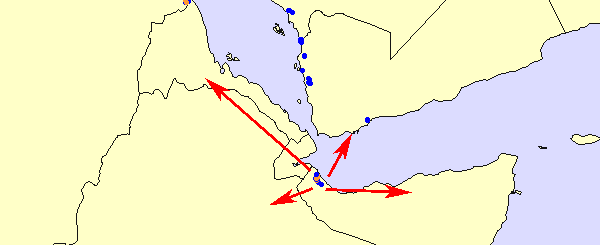
Small swarms will form in NW Somalia and could move into neighbouring countries.
2 March. Hatching & band formation on the Sudanese coast
Eggs laid by swarms are now hatching on the Red Sea coast in Sudan near the Eritrean border. The hatchlings are reported to be forming small high-density hopper bands. The infestations are concentrated in a relatively small area of green vegetation (about 7 by 15 km) on the coastal plains. Aerial and ground control operations are underway. A Green Muscle® biopesticide trial will be carried out in March. The situation is less clear in adjacent coastal areas of Eritrea where survey and control operations are thought to continue against small groups, bands and swarms.
The situation in Sudan and Eritrea is very serious because breeding conditions continue to remain favourable. If more rain falls in March, further breeding will cause locusts to rapidly increase, and hopper bands and swarms could form that would threaten the Red Sea region.
Elsewhere in the region, unconfirmed reports suggest that locusts are increasing on the coast of northwest Somalia. Local breeding is underway on the Red Sea coast of Saudi Arabia and Yemen; some control operations were recently carried out in Saudi Arabia.
FAO missions will visit Eritrea and Somalia in early March to clarify the situation.
The situation remains calm in West and Northwest Africa - only isolated populations are present in northwest Mauritania and near the Morocco/Algeria border. The situation is also calm in Southwest Asia where low numbers of adults are present along the coast in the spring breeding areas of western Pakistan.
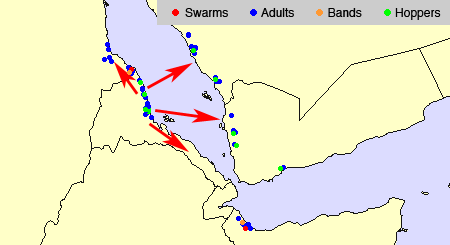
Situation level: CAUTION (for the Central Region)
16 February. Desert Locust control operations continue on Red Sea coast
Ground control operations continue on the Red Sea coast in Eritrea where a Desert Locust outbreak developed in early December. Hoppers and adults are gregarizing and forming small groups between Massawa and the Sudanese border. The infestations extend across the border onto the coastal plains of Sudan near Karora where a few swarms have appeared and aerial control operations are in progress. During the past week, rain fell in the infested areas in both countries. Consequently, a second generation of breeding is underway that could give rise to small hopper bands and swarms in March. Adults may move north or south along the coast or cross the Red Sea to Yemen or Saudi Arabia. More rains could cause the situation to deteriorate further and a potentially dangerous situation may develop in the coming months.
FAO has alerted neighbouring countries who have increased the number of survey teams in the winter breeding areas along both sides of the Red Sea. So far, only small-scale breeding has been detected on the coast of Saudi Arabia and Yemen. Elsewhere in the region, adults are forming small groups on the northwest coast of Somalia where conditions are unusually favourable for further breeding. A swarm was reported in this area but it could not be confirmed.
The situation remains calm in West and Northwest Africa and in Southwest Asia.
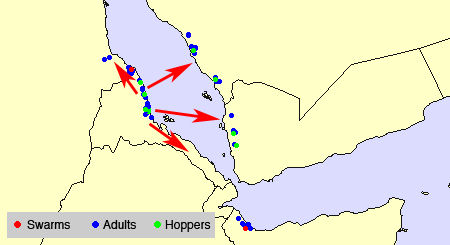
Situation level: CAUTION (for the Central Region)
2 February. Desert Locust outbreak continues on Eritrean Red Sea coast
A Desert Locust outbreak that developed in early December on the northern coastal plains of the Red Sea in Eritrea is continuing despite control efforts. Some of the infestations have spread across the border into adjacent coastal areas of Sudan. Hoppers and adults are forming small groups and a second generation of breeding is underway that could give rise to small hopper bands and swarms in March. Adults may move north or south along the coast or cross the Red Sea to Yemen or Saudi Arabia. More rains could cause the situation to deteriorate further and a potentially dangerous situation may develop by May.
Neighbouring countries have been alerted and are increasing the number of survey teams in the winter breeding areas along both sides of the Red Sea. So far, only small-scale breeding has been detected on the coast of Saudi Arabia and is likely to start in Yemen. Elsewhere, adults are forming small groups on the northwest coast of Somalia where conditions are unusually favourable for further breeding.
The situation is calm in West and Northwest Africa and in Southwest Asia.
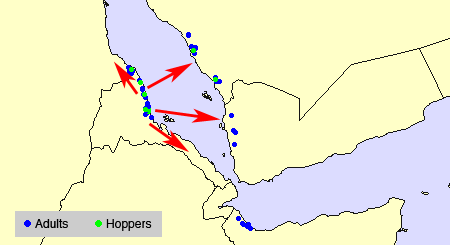
Situation level: CAUTION (for the Central Region)
8 January. Desert Locust outbreak continues on Eritrean Red Sea coast
A local outbreak is in progress on the central Red Sea coast in Eritrea where it developed as a result of good rainfall and green vegetation in November and December 2006. The infestations are limited to a small area near Shieb and Shelshela agricultural areas where groups of hoppers and adults are present. Hoppers are fledging and adults are laying eggs. A second area, Meleet, is infested further north on the coast near the Sudanese border where similar populations have been reported. Solitarious adults are scattered elsewhere along the coast to Tio, and egg-laying and hatching are are likely to occur this month. Seven survey and control teams are in the field, and more than 11,000 ha were treated from 9 to 27 December.
In other countries, no significant developments have occurred in the past two weeks. Ground control operations continue in the central Tamesna Plains of Niger against hoppers and adults. Locust infestations have declined in northwest Mauritania and in Western Sahara where only small residual populations remain. Small-scale breeding will occur during January on the Red Sea coast in Sudan, Saudi Arabia and Yemen, and along the coast of northwest Somalia.
OTHER LOCUSTS. Control operations are in progress against Brown Locust infestations in southwest Lesotho and Karoo, South Africa - the worst in many years. Control is also underway in southeast Zimbabwe against African Migratory Locust.
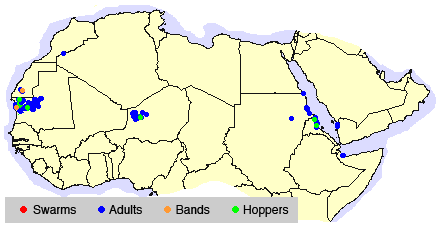
Situation level: CAUTION (for the Central Region; Eritrea in particular)




